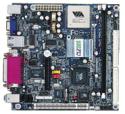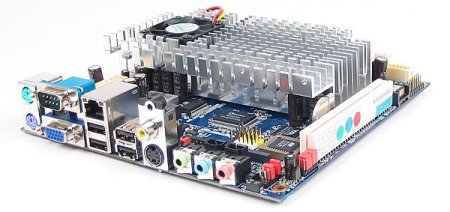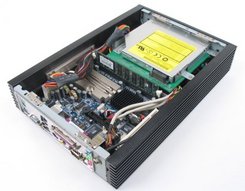Article: Using Mini-ITX for embedded computing
May 12, 2006 — by LinuxDevices Staff — from the LinuxDevices Archive — 5 views Foreword — This article summarizes the appearance, evolution, and current state of Mini-ITX as a form-factor for embedded applications. It was written by Roland Groeneveld, who founded Logic Supply, a PC board and parts distributor specializing in Mini-ITX. Enjoy . . . !
Foreword — This article summarizes the appearance, evolution, and current state of Mini-ITX as a form-factor for embedded applications. It was written by Roland Groeneveld, who founded Logic Supply, a PC board and parts distributor specializing in Mini-ITX. Enjoy . . . !
by Roland Groeneveld
Annual growth rates of over 30 percent indicate that the Mini-ITX form-factor has “crossed the chasm” of acceptance in the embedded community. As a solutions provider focused exclusively on this form-factor, we are told by embedded developers that Mini-ITX's combination of value, widespread availability, feature choice, and ease of development makes it an ideal board for many applications.
Yet many engineers remain hazy about where the form-factor originated, ask us about the range of technical features available, appropriate applications, and the form-factor's future directions. For those looking to learn more about Mini-ITX, read on.
Overview
Mini-ITX is an off-the-shelf mainboard form-factor measuring 17 x 17 cm (6.7 x 6.7 inches). The standard was pioneered by VIA Technologies, which introduced Mini-ITX boards as a reference design to showcase their core products — chipsets and processors. The VIA EPIA line of Mini-ITX motherboards was launched as a commercial product in 2002. Logic Supply, a U.S.-based Mini-ITX distributor and solutions provider, started offering this new form-factor and related components shortly thereafter.
Technically, Mini-ITX boards are defined by their layout, size, degree of integration, and compatibility with PC components. The layout of the mounting holes, back panel I/O shield, and PCI slot is similar to ATX style PC boards. But, at 17 x 17 cm, the mainboard is significantly smaller than a traditional ATX PC board and suitable for many applications where smaller, but not micro, sizing is required. The available extra real estate on the Mini-ITX board creates ample space for integrated I/O.
Significantly, this standardized layout allows for easy integration with PC components. This has encouraged the rapid development of Mini-ITX specific chassis. Manufacturers Morex and Casetronic offer very small (mobile) cases, expandable cases with PCI slots, and rackmount cases. Serener has created a relatively new solution — a range of fanless Mini-ITX cases using heat pipe technology. And because Mini-ITX boards are x86 compatible, they support all major operating systems including Windows XP, Windows Embedded, and Linux.

Figure 1: VIA EPIA EN15000 Mini-ITX mainboard
(Click to enlarge)
Available Features
Currently, there are dozens of manufacturers making Mini-ITX form-factor boards. In addition to VIA, Mini-ITX boards are offered by Commell, iBASE, DFI-ACP, and Arbor, as well as such leading embedded players such as Kontron, Advantech, and Axiomtek. Recently, motherboard manufacturer AOpen launched its own line of Mini-ITX boards. With this proliferation of players, the range of available features has greatly expanded.
There are, in general, three classes of boards: (1) VIA EPIA and VIA processor based mainboards; (2) ultra low voltage Intel and AMD Geode based Mini-ITX boards; and (3) faster Pentium M and Pentium 4 based boards, usually offered without an integrated processor.
The VIA EPIA line represents more than 50 percent of the Mini-ITX market. The line includes boards based on the VIA Eden / C3 processor, as well as the newer, more powerful C7 chip. VIA's boards generally offer power efficiency along with a very good price to performance ratio. The newer boards also include the latest technologies, such as SATA, DDR2 400/533 memory, Gigabit Ethernet, and DVI.
Other manufacturers like Kontron, Axiomtek, and Commell are focusing their Mini-ITX efforts mainly around Intel processors. ULV, Celeron M, and Pentium M processors allow for more powerful solutions while maintaining low power usage and heat dissipation. Pentium 4 solutions are also available, but generally the resulting power and cooling requirements are difficult to combine with small size requirements.
All Mini-ITX boards have a range of I/O ports available: serial, parallel, USB, Firewire, keyboard/mouse, audio, VGA, TV and S-video out, 10/100 LAN, floppy, and IDE ports are standard. The more advanced boards feature on-board CompactFlash and PCMCIA slots, DVI, LVDS, RGB, Gigabit LAN, Serial ATA (SATA), and programmable digital I/O ports.
Moreover, all Mini-ITX motherboards come with a PCI or PCI-Express slot and some also include mini-PCI, enabling additional add-ons like video capture cards, extra network or wireless interfaces. With the use of dual PCI riser cards it's possible to add two PCI cards. Most mainboards use standard DDR266 or DDR400 memory or the newer and faster DDR2 memory. The high-end Mini-ITX boards offer a watchdog timer and standard system monitoring interfaces, not unlike many embedded computer boards.
For an overview of some popular Mini-ITX motherboards refer to the Logic Supply Mainboard Matrix.
Comparison to other form-factors
The Mini-ITX board has historically straddled the PC and the embedded computing worlds. Increasingly, though, the board is used as an alternative to other embedded mainboard standards. Figure 2 shows Mini-ITX's size in relation to other form-factors.

Figure 2: Form-factor comparison
(Click to enlarge)
EBX Mini-ITX EPIC Nano-ITX ETX PC/104 |
146 x 203 170 x 170 115 x 165 120 x 120 95 x 114 90 x 96 |
296 289 190 144 108 86 |
The Mini-ITX form-factor speeds development time, is widely available, and is, in general, quite economical.
With a range of compatible accessories like enclosures, power supplies, CF adapters, riser cards, and IDE adapters, it's possible to quickly set up a working prototype without designing a custom enclosure. Tens of thousands of VIA boards are sold each month in Asia, Europe, and the U.S. The broad appeal of the product ensures availability, and shortens manufacturing lead times. And retail prices for VIA Mini-ITX boards range from $129 to $225. Prices for Pentium M and P4 compatible boards are higher, but few socket-version boards break $350. While there are certainly other form-factors that offer comparable per unit costs, most require up-front development costs that Mini-ITX minimizes.
Applications
Logic Supply regularly works with engineers to develop and refine Mini-ITX based devices and embedded systems. We are seeing applications that range across the embedded spectrum. Historically, Mini-ITX systems have been used in applications such as:
- Digital signage
- Kiosks
- Gaming
- Data logging
- Communications
- Network monitoring
- Point of sales
Moreover, as the multimedia capabilities of Mini-ITX boards have expanded, we are seeing more graphically intensive applications, such as video security, digital entertainment devices, and set top boxes.
Additionally, as embedded players have begun Mini-ITX production, we have recently begun to see more robust solutions. Extreme temperature swings, high-vibration situations, and deployments lasting five or more years still challenge Mini-ITX boards, however; as a result, less work is done in the military market. But fanless boards and fanless, solid-state embedded PCs have expanded the range of applications into many traditional “embedded” areas, including:
- Industrial control
- Machine vision
- Harsh environment PCs
- Medical
- Robotics
Mini-ITX based systems can be tougher than you might suppose. Processor fans, enclosure fans, and hard drives are typical points of failure. A fanless solid state system (utilizing flash memory) eliminates these weak points. Fortunately, both fanless and solid state systems are easy to create in this form-factor, due to the low power, low heat characteristic of most Mini-ITX boards.
We are seeing an increasing number of embedded Linux based applications. Linux has traditionally been a PC operating system. As a result, Linux best supports hardware and architectures that are common in personal computers. While other embedded platforms are built upon special-purpose components, Mini-ITX boards are generally based on standard PC components, including processors, core logic chipsets, peripheral interfaces chips, and even I/O connectors. This translates into vastly improved compatibility with Linux, the free BSD's, and their derivatives. As a result, embedded developers using Mini-ITX platforms spend less time on operating system integration, and more time writing application code, and can have confidence that their device drivers have been thoroughly tested in thousands of production systems around the world.
Case Studies
Use of Mini-ITX in relatively-rugged embedded computing applications is increasing as customers realize the possibilities and benefits of this form-factor.
For example, a division of a major U.S. Steel company uses fanless, solid state Mini-ITX systems at its melt shop operation. The melt shop engineer explains, “We are turning scrap metal into structural steel and the different grades of scrap determine the quality of the mix and, ultimately, the steel itself. The Mini-ITX systems are used as a mobile appliance inside the grapple crane's cab. It contains a wireless card that allows the operator to access and interface with our inventory management system. Materials loading is now database-driven.”


Figure 3: Fanless Mini-ITX system and application environment
Of course, the bread and butter applications for Mini-ITX are less demanding. A Canadian digital signage company that specializes in restaurant-based advertising says, “Mini-ITX systems serve as our digital media players, and work in a 1:1 or 1:2 relationship with our plasma displays.” The company chose an economical 600MHz based system to display its relatively static content. Other digital signage companies, by contrast, are utilizing Pentium M systems based around boards such as the Commell LV-675 to enable more media-rich content.
The Future of Mini-ITX
This spring and summer, VIA is introducing a range of new Mini-ITX motherboards — models EN, CN, EK — with a highly efficient, low power C7 processor. In the release of the EN, VIA writes that “the onboard 1.5GHz VIA C7 or fanless 1.2GHz VIA Eden processor boasts exceptionally low average power consumption of less than 1 Watt, and employs the proprietary bandwidth-efficient VIA V4 bus to deliver a solid performance increase in a complete range of applications over equivalent VIA C3 processors.” Also planned, is support for the new High Definition Multimedia Interface (HDMI), which offers 8-channel digital audio, High Definition video, and data (including I2C); HDMI is backwards compatible with DVI, but it uses a much smaller connector, which is always good news for the embedded market.
VIA's long awaited Nano-ITX motherboards are finally available. Measuring 12 x 12 cm (4.7 x 4.7 inches), this form-factor is even smaller than the Mini-ITX, while maintaining full PC compatibility from the functional perspective. The Nano-ITX is designed around the VIA Luke CoreFusion Processor, which has an integrated North Bridge. With integrated audio, video, LAN, SATA and much more, this is the smallest multi-media capable single board computer (SBC) available on the market.
Summary
Embedded engineers will continue to weigh the pros and cons of their system board choices. There are certain very rugged embedded applications where the PC/104, EBX, EPIC, and other SBC form-factors shine. However, Mini-ITX lends itself easily and reliably to many applications traditionally viewed as core to the embedded market. For less extreme uses, Mini-ITX offers a great alternative to traditional embedded SBC solutions.
Useful Mini-ITX resources
 About the author — Roland Groeneveld is founder and president of Logic Supply, Inc., a Mini-ITX distributor and solutions provider. His background is in global IT consultancy with LogicaCMG in Europe, and IT management at Tiscali, a large European ISP. He has degrees in electrical engineering and computer science.
About the author — Roland Groeneveld is founder and president of Logic Supply, Inc., a Mini-ITX distributor and solutions provider. His background is in global IT consultancy with LogicaCMG in Europe, and IT management at Tiscali, a large European ISP. He has degrees in electrical engineering and computer science.
This article was originally published on LinuxDevices.com and has been donated to the open source community by QuinStreet Inc. Please visit LinuxToday.com for up-to-date news and articles about Linux and open source.